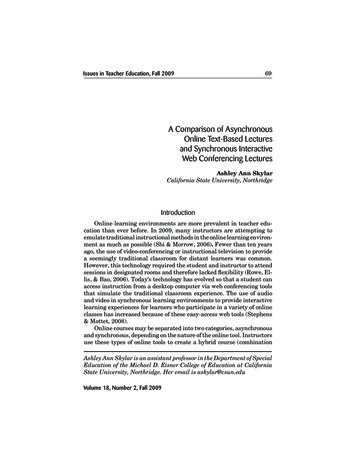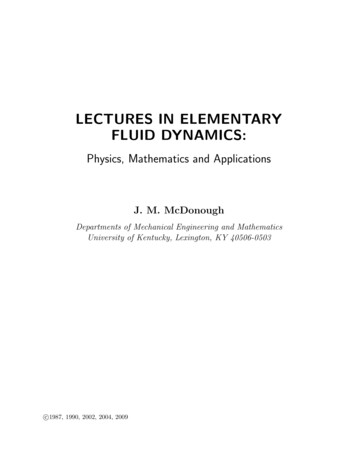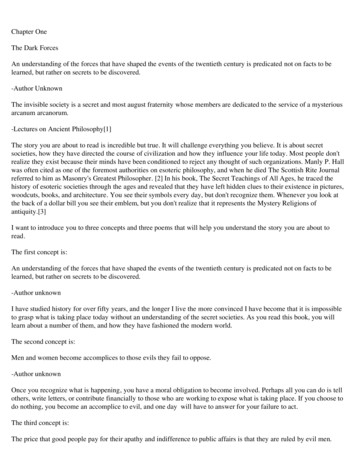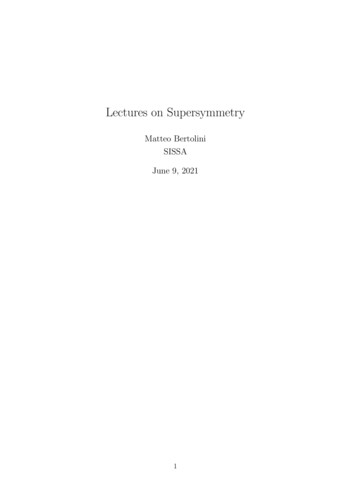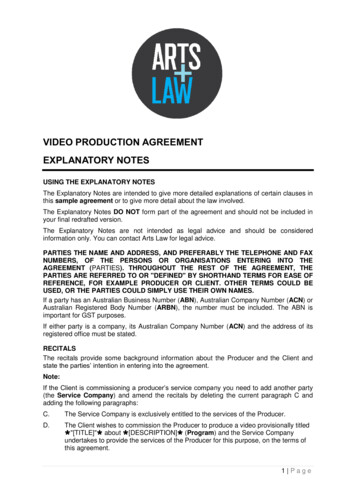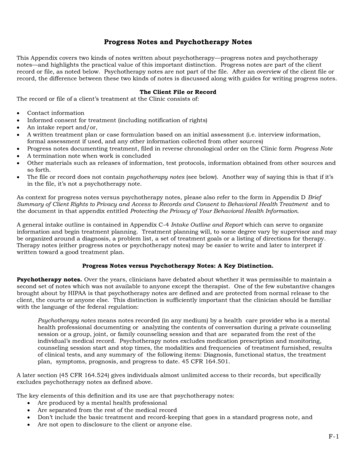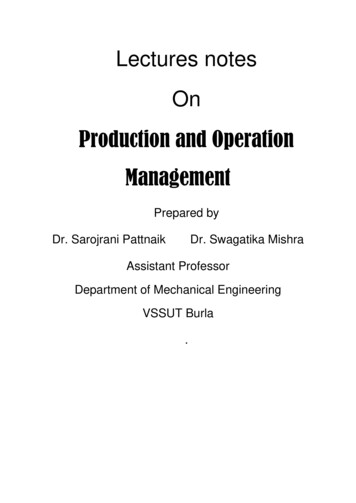
Transcription
Lectures notesOnProduction and OperationManagementPrepared byDr. Sarojrani PattnaikDr. Swagatika MishraAssistant ProfessorDepartment of Mechanical EngineeringVSSUT Burla.
PRODUCTION AND OPERATION MANAGEMENT(3-0-0)1.2.3.4.Productivity : Importance, productivity ratio, productivity measurement,productivity index, awareness — improvement — maintenance (A.I.M)proceSs.Production System Models of production system, Product Vs. Services,Process-focused & product focused systems, product strategies, productlife cycle, production function.Forecasting : Methods — moving average, exponential smoothing,Regression analysis, coefficient of co-relation, Delphi, Market survey.Facilities Planning : Site location, facilities layout and various types,planning using CRAFT work place design, working conditions — noiseillumination etc.Motion study — principles of motion — economy, Time study-standard time.Production Planning & Control : Aggregate planning. Sequencing, Linebalancing, Flow control, Dispatching, expediting, Gantt chart, line ofbalance, learing curve.7.Project Management — Network scheduling, PERT. Critical path, Mostlikely time estimate , Resource leveling.8.38.Modern Trends in Manufacturing :Basic concepts of CAD,CAM,FMS, CIM,ISO 9000, Quality circle, Kaizen, Kanbans, Poke Yoke' supply chainmanagement.Text Books1.Production Systems : Planning, Analysis & Control : By — Riggs, J.L.(4thEdn.) John Wiley & Sons2.Modern Production/Operation management : By — Buffa, E.S. & Sarin, ,.K.(8 " Edn.) John Wiley & Sons.3.Production & Operations Management : By Panneer saivem, R.(2' 1 Edn.)PHI4.Production & Operations Managem ent : By Chary, S.N.(TMH)5.6.
VEER SURENDRA SAI UNIVERSITY OF TECHNOLOGY BURLAHADEPARTMENT OF MECHANICALLESSON PLAN FOR Production and Operation ManagementSUBJECT CODE: 8th SemesterLectureTopics to be coveredLecture 1Productivity: Importance, productivity ratio, productivitymeasurement, productivity indexLecture 2Awareness – improvement – maintenance (A.I.M) process,Production System, Models of production systemLecture 3Product Vs. Services, Process-focused & product- focused systemsLecture 4Product strategies, product life cycle, production functionLecture 5Forecasting: MethodsLecture 6Moving average, Exponential smoothingLecture 7Regression analysis, coefficient of co-relationLecture 8Delphi, Market surveyLecture 9Facilities planning: Site location, facilities layoutLecture 10 Types of facility layout, Planning using CRAFT work place designLecture 11 Working conditions – noise illumination etc.Lecture 12 Problems on single facility location using median methodLecture 13 Problems on single facility location using minimax method andgravity methodLecture 14 Problems on single facility location using Euclidean-distancelocationLecture 15 Motion study, Principles of motion- economy, method studyLecture 16 Rules concerning human body, workplace layout and materialshandling,Lecture 17 Rules concerning tools and equipments design, time conservationLecture 18 Time study and work measurement techniquesRemark
Lecture 19 Performance rating and different types of allowancesLecture 20 Production planning and control- Aggregate planningLecture 21 Sequencing and line balancingLecture 22 Flow controlLecture 23 Dispatching, centralized and decentralized dispatchingLecture 24 Expediting and Gantt chartLecture 25 Line of balance and learning curveLecture 26 Project management, network schedulingLecture 27 PERT with problemsLecture 28 ProblemsLecture 29 Critical path method with problemsLecture 30 ProblemsLecture 31 Resource levellingLecture 32 Basic concepts of CAD, CAM, FMSLecture 33 CIM, JIT, ISO 9000Lecture 34 Quality circle, Kaizen, KanbansLecture 35 Poke Yoke, Supply chain managementLecture 36 Revision of problemsLecture 37 Revision of problemsLecture 38 Revision of problemsLecture 39 Revision of problemsLecture 40 Revision of problems
CHAPTER-IPRODUCTIVITY1.1 IntroductionProduction/Operation management is the process which combines and transforms variousresources used in the production/operation subsystem of the organization into value addedproducts/services in a controlled manner as per the policies of the organization.Resources used inproduction/ operationsubsystemValue added products/servicesTransform(In controlled manner asper the policies of the organization)Production/Operation function:Range of inputsRequired output (product/service)(Having the requisite quality level)The set of interrelated management activities which are involved in manufacturing certainproducts is called production management and for service management, then corresponding setof management activities is called as operation management.Examples: (Products/goods)Boiler with a specific capacity,Constructing flats,Car, bus, radio, television.Examples: (Services)Medical facilities,Travel booking services.In the process of managing various subsystems of the organization executives atdifferent levels of the organization need to track several management decisions.The management decisions are Strategic, tactical and operational.Strategic (Top level)Defining goalsMaking policiesTactical (Middle level)Plant locationnew product establishmentMonitoring of budgetsOperational (Bottom level)effective andefficient utilizationof resources
Corrections from feedback information: Tight quality check on the incoming raw-material.Adjustment of machine settings.Change of tools.Proper allocation of operations to machines with matching skills.Change in the production plans.1.2 Productivity:Productivity is a relationship between the output (product/service) and input (resourcesconsumed in providing them) of a business system. The ratio of aggregate output to theaggregate input is called productivity.Productivity output/Input For survival of any organization, this productivity ratio must be at least 1.If it is morethan 1, the organization is in a comfortable position. The ratio of output produced to theinput resources utilized in the production.1.3 Importance:Benefits derived from higher productivity are as follows: It helps to cut down cost per unit and thereby improve the profits. Gains from productivity can be transferred to the consumers in form of lower pricedProducts or better quality products. These gains can also be shared with workers or employees by paying them at higher rate. A more productive entrepreneur can have better chances to exploit expert opportunities. It would generate more employment opportunity. Overall productivity reflects the efficiency of production system. More output is produced with same or less input. The same output is produced with lesser input. More output is produced with more input. The proportional increase in output being more than the proportional increase in input.1.4 Productivity Measurement:Productivity may be measured either on aggregate basis or on individual basis, which are calledtotal and partial measure.Total productivity Index/measure Total output/ Total input Total production of goods and servicesLabour material capital Energy managementPartial productivity indices, depending upon factors used, it measures the efficiency of individualfactor of production.2
Labour productivity Index/Measure Output in unitMan hours workedManagement productivity Index/Measure OutputTotal cost of managementMachine productivity Index/Measure Total outputMachine hours workedLand productivity Index/Measure Partial Measure OutputLabourOutput or Outputor OutputCapitalMaterialsEnergyorTotal outputArea of Land usedPROBLEMS:Example-1The input and output data for an industry given in the table. Find out various productivitymeasures like total, multifactor and partial measure.Output and Input production data in dollar ( )Output1.2.3.4.5.Finished unitsWork in progressDividendsBondsOther income10,0002,5001,000--------------Input1. Human3,0002. Material1533. Capital10,0004. Energy5405. Other Expenses1,500Solution:Total measure Total Output 13,500 0.89Total Input15,193Multi factor measure Total Output 13,500 4.28Human Material 3,153Multi factor measure Finished units 10,000 3.17Human Material3,153Partial Measure1 Total Output 13,500 25Energy540Partial Measure2 Finished units 10,000 18.52Energy5403
Note: For multifactor and partial measures it is not necessary to use total output as numerator.Often, it is describe to create measures that represent productivity as it relates to some particularoutput of interest.Other fields for the measurement of partial measures of productivity are:BusinessRestaurantRetail StoreUtility plantPaper millProductivity MeasureCustomers (Meals) per labour hourSales per square footKilowatts per ton of coalTons of paper per cord of woodExample-2A furniture manufacturing company has provided the following data. Compare the labour,raw materials and supplies and total productivity of 1996 and 1997.Output: Sales value of production in dollar ( )22,000 (in 1996) and 35,000 (in 1997)1996Inputs: Labour10,000Raw materials and Supplies8,000Capital equipment 0Solution:a. Partial productivitiesLabourRaw materials and Suppliesb. Total Productivity199619972.202.751.052.332.801.041.5 Productivity measurement approaches at the enterprises level:As stated above total productivity is expressed as the ratio of aggregate output to the aggregateinput. That the total overall performance is captured in this ratio, becomes apparent, if weexamine the relationship between this ratio and the age-old performance measure of profit.If the outputs and input for the period for which productivity is measured, are expressed inrupees, then under such restrictive assumptions one can write:Aggregate output Gross Sales G (Say)Aggregate input Cost C (Say)4
Total Productivity P(Say) GC .(1)From the definition of profit, we have;Profit π G-CBy dividing eqn (2) by C,So from (1), .(2) C CG 1C P-1For Zero profit ( 0), P 1For a Loss, ( 0), P 1For a profit, 0, P 1Zero profit will give a productivity value of 1, while a loss will give productivity value less than1.The profit to cost ratio will determine the increase in productivity.The above relationship that demonstrates that increased profit to cost ratio will lead to increasedoverall productivity, is constituent with our expectation on how an overall performance measureshould behave. However it suffers from a number of drawbacks. Some of which are listed here,a) Given that our objective in productivity measurement is to capture the efficiency ofutilization of resources, the effect of price variations over time need to be corrected. Thusaggregate output should be equal to gross sales suitably inflated or deflated with respectto a base year.b) Equating output to sales implies, whatever is produced in the particular period is sold.Possibility of inventory, material manufactured for own use, etc. are n’t taken in toconsideration.c) Equating aggregate input to cost raises a host of problems and involves several restrictiveassumptions. How to account for the fixed investment and working capital, whether totake the fringe benefits in to account etc. are some of the problems.The different approaches to measurement have arisen mainly in the context of correcting theabove drawbacks.1.6 Techniques for Productivity Improvement:Higher productivity in organization leads to national prosperity and better standard of livingfor the whole community. The methods contribute to the improvement of productivity aremethod study and work measurement by reducing work content and Ineffective time.5
Work content means the amount of work “contained in” a given product or process measuredin man-hour or machine-hour. Except in some cases like in processing industries, actualoperation times are far in excess of the theoretical minimum.Ineffective time is the time for which the worker or machine or both are idle due to theshortcomings of the management or the worker.6
CHAPTER-IIPRODUCTION SYSTEM2.1 IntroductionA “Production System” is a system whose function is to transform an input into a desired outputby means of a process (the production process) and of resources. The definition of a productionsystem is thus based on four main elements: the input, the resources, the production process andthe output.ResourcesInput-Production Process-OutputMost of the organizations (including non-profit organization) can be described as productionsystems.These organizations transform (or convert) a set of inputs (such as materials, labour,equipment, energy etc.) in to one or useful outputs. The outputs of a production system arenormally called products. These products may be:(a)Tangible goods(b)Intangible services(c)combination of (a) and (b)(Steels,chemicals etc.) (Teaching,health care etc.) (fast food,tailoring etc.)INPUT ONPROCESSOUTPUT Goods ServicesFeedback & RequirementsFig 2.1 A simple block diagram of a production systemProduction system refers to manufacturing subsystem that includes all functions required todesign, produce, distribute and service a manufactured product. So this system produces goodsand/or services on a continuous and/or batch basis with or without profit as a primary objective.7
Production is the basic activity of all organizations and all other activities revolve aroundproduction activity. The output of production is the creation of goods and services which satisfythe needs of the customers. In some organization the product is physical (tangible) good. Forexample, refrigerators, motor cars, television, toothpaste etc., while in others it is a service(insurance, healthcare etc.).The production system has the following characteristics: Production is an organized activity, so every production system has an objective.The system transforms the various inputs (men, material, machines,information,energy)to useful outputs (goods and/o
Modern Production/Operation management : By — Buffa, E.S. & Sarin, ,.K.(8 " Edn.) John Wiley & Sons. 3. Production & Operations Management : By Panneer saivem, R.(2'1 Edn.) PHI 4. Production & Operations Management : By Chary, S.N.(TMH) VEER SURENDRA SAI UNIVERSITY OF TECHNOLOGY BURLAHA DEPARTMENT OF MECHANICAL LESSON PLAN FOR Production and File Size: 1MBPage Count: 98

